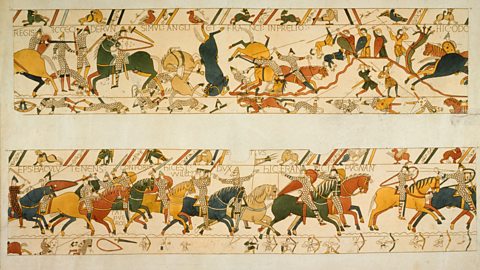Key themes of the Norman Conquest
- Conquest
- Consolidation
- Construction
- People
Conquest
chroniclerA person who records events for historical record. writing years after 1066 describe Harold Godwinson in negative terms. He was certainly the most powerful man in England, even whilst King Edward was still alive, but many saw him as an usurperOne who usurps - seizes and holds (a position, office, power, etc) by force or without legal right. and a perjurerTo render (oneself) guilty of swearing falsely or of wilfully making a false statement under oath.. In 1064 Harold had sworn an oath to William of Normandy that he would support him as the heir to the English throne.
Williamās successful invasion, which climaxed in a decisive victory over Haroldās forces at Hastings in 1066, was a huge moment. Harold, along with almost all of the English nobility, died at Hastings. The south of England was firmly under Williamās control after his victory at Hastings, however he would have difficulty securing his kingdom against rebellious northern earls, Welsh princes and Danes who still believed they had a valid claim to the English crown.
Consolidation
William faced major challenges to his authority between 1068 and 1070. The most serious rebellions took place in the north of England and for a few months it seemed as though the Normans would be forced out of England altogether. Williamās response, known as the āHarrying of the Northā was incredibly brutal, even by the standards of medieval Europe.
After his successful defeat of rebellious English earls, the process of NormanisationThe way England was changed by the Normans after the conquest by William in 1066. was implemented throughout England. French became the language of government and almost all the major landowners were Normans by 1075. The change in land ownership from 1066 to 1086 was recorded in the Domesday Book which was the most extensive public survey in Europe at the time.
Construction
The Normansā greatest achievements were architectural. They were master builders and introduced the Romanesque style to England. Hundreds of castles, abbeys and cathedrals were built during the reign of William and his son William Rufus. These imposing structures served different purposes but they all reminded the population that the Normans were to be a permanent presence in England.
The social construct of feudal systemThe feudal system was a way of organising society into different groups based on their roles. It had the king at the top with all of the control, and the peasants at the bottom doing all of the work. relied on castles and churches. God, represented on earth by the Church, was at the top of the feudal pyramid. The king derived his authority from God and his authority was demonstrated through his wealth and the power of his military. The king owned all the land and he gave most of this away to the Church or to loyal supporters in exchange for tax and military service. Castles were needed to remind ordinary people of their responsibility to their lord - this included offering their labour or paying taxes as well as obeying the law.
People

Major events in medieval Europe, such as battles and treaties, were the consequence of the actions of very few individuals. Most of the sources we have about Norman England focus on the actions of a small number of people. A good example is the Bayeux Tapestry (an embroidered cloth), which includes almost all the key figures of the conquest. Edward the Confessor, Harold Godwinson, William the Conqueror, Bishop Odo and Archbishop Stigand are all depicted in the tapestry. The chronicles of William of Malmesbury, Orderic Vitalis and the anonymous Anglo-Saxon ChronicleThe Anglo-Saxon Chronicle is a collection of annals in Old English chronicling the history of the Anglo-Saxons. The original manuscript of the Chronicle was created late in the 9th century, probably in Wessex, during the reign of Alfred the Great. It was continued until the end of the Norman conquest in the 11th century. describe the other key figures such as Earls Edwin and Morcar, Harald Hardrada and William FitzOsbern.
More guides on this topic
- Anglo-Saxon society pre-1066 - Edexcel
- Edward's death and claimants to the throne - Edexcel
- 1066 - the battles - Edexcel
- Revolt, resistance and control in Norman England - Edexcel
- Norman rule - Edexcel
- Castles in Norman England - Edexcel
- The Church in Norman England - Edexcel
- The Normans - exam preparation - Edexcel